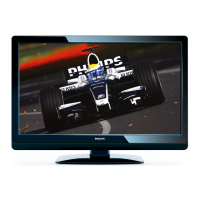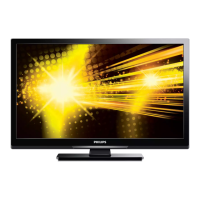
Do you have a question about the Philips 32PF5320/28 and is the answer not in the manual?
Details on display, resolution, contrast, audio, power consumption, and dimensions.
Describes side and rear I/O connections, including pinouts for various connectors.
Diagram showing the main internal panels and their physical locations within the chassis.
Procedures and regulations for safe repair, including isolation transformer and component substitution.
Critical precautions regarding ESD, high voltage, and component handling during service.
General notes, lead-free solder guidelines, and practical service precautions for repairs.
Instructions on routing and securing internal wiring harnesses for proper assembly and cable management.
Describes methods and accessories for safely positioning the TV for servicing and measurements.
Procedures for safely removing internal panels like the rear cover, side I/O, and keyboard.
Guidelines for reassembling the TV set correctly in reverse order of disassembly.
Locating and using specific test points indicated in schematics for measurements and diagnostics.
Overview of Service Default Mode (SDM), Alignment Mode (SAM), and Customer Service Mode (CSM).
Addresses common picture problems like dark/bright display and white lines using service modes.
Introduction to ComPair and LVDS tools for detailed diagnostics and fault identification.
Procedures for reading, clearing, and interpreting error codes from the TV's memory.
Using the front LED to display error codes, useful when the screen is blank.
General tips and advice for effective troubleshooting, including NVM Editor usage.
Diagram showing physical connections between major assemblies and connectors.
Schematic of the video signal path from tuner to scaler.
Schematic of the audio signal path, including tuning, Hercules, and amplifier.
Layout showing important test points on the small signal board for diagnostics.
Diagram showing ICs communicating via I2C bus and their interconnections.
Diagram illustrating power supply lines and voltages distributed throughout the TV.
Detailed schematic for the tuner and VIF section, including component placement.
Schematic of the main Hercules IC, showing its internal functions and pins.
Schematic for the sync interface circuitry, handling Hsync and Vsync signals.
Schematic of the audio processing section, including volume, tone, and surround sound.
Schematic for the DC-DC converter circuits providing various supply voltages.
Schematic of the scaler IC, responsible for image scaling and processing.
Schematic for digital I/O including VGA, PC audio, and HDMI connections.
Schematic for analog I/O ports using Cinch connectors, including CVBS and audio.
Overview of component placement on the top side of the small signal board.
Detailed layout of components on the top side of the small signal board, Part 1.
Detailed layout of components on the top side of the small signal board, Part 2.
Detailed layout of components on the top side of the small signal board, Part 3.
Detailed layout of components on the top side of the small signal board, Part 4.
Overview of component placement on the bottom side of the small signal board.
Detailed layout of components on the bottom side of the small signal board, Part 1.
Detailed layout of components on the bottom side of the small signal board, Part 2.
Detailed layout of components on the bottom side of the small signal board, Part 3.
Detailed layout of components on the bottom side of the small signal board, Part 4.
Schematic of the Class D audio amplifier circuit, showing its components and connections.
Component layout for the top side of the Class D audio amplifier board.
Component layout for the bottom side of the Class D audio amplifier board.
Schematic of the keyboard control panel, showing button connections and circuitry.
Component layout for the top side of the keyboard control panel.
Component layout for the bottom side of the keyboard control panel.
Schematic of the side A/V panel, including SVHS, CVBS, and headphone connections.
Component layout for the top side of the side A/V panel.
Component layout for the bottom side of the side A/V panel.
Schematic for the IR receiver, LED, and light sensor components.
Essential conditions and environment for performing electrical adjustments.
Notes that no hardware alignments are specified for this LCD TV model.
Using SAM to adjust geometry, white tone, and tuner (IF) settings.
Overview of the SAM menu structure, options, and settings like AGC and IFPLL.
Steps for adjusting AGC and IFPLL settings via the SAM menu for optimal tuner performance.
Procedure for aligning the Digital Xtal Oscillator for correct NICAM audio reception.
Using NVM Editor to set ADC gain, greyscale, and panel size parameters.
Notes on sound adjustments, specifically for NICAM sets.
How to change HERCULES features/settings via SAM or NVM Editor.
Overview of the LC4.3 LCD TV, its models, and picture qualities.
High-level diagram of the TV's architecture, showing major functional blocks.
Details on rear and side AV, PC, and HDMI input/output connections.
Description of the tuner and IF amplifier section, including AGC operation.
Description of video processing in the TV section, including Hercules functions.
Detailed explanation of the Columbus IC's comb filter and noise reduction capabilities.
Description of the scaler IC's functions, including scaling, inputs, and outputs.
Explanation of the audio processing chain, including decoding and diversity.
Lists the extensive audio and video features provided by the Hercules IC.
Description of the two main micro-controllers (Hercules and OCM) and their I2C bus.
Glossary of common abbreviations used throughout the manual.
Internal block diagrams and pin configurations for key integrated circuits.












